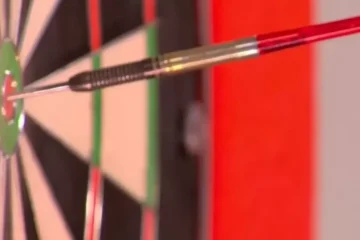To stop your darts fishtailing, ensure a smooth release and follow through with your throw. Adjust your grip, stance, and throwing motion as needed to maintain control of the dart’s flight.
Fishtailing occurs when the dart wobbles left and right during flight, usually due to inconsistent release or improper throwing technique. Darts fishtailing can be frustrating, especially when you’re aiming for precision and accuracy. Whether you’re a beginner or an experienced player, mastering the art of a steady throw is crucial for improving your game.
By understanding the causes of fishtailing and implementing the right adjustments, you can effectively eliminate this issue and enhance your dart-throwing skills. In this guide, we’ll explore the common reasons behind fishtailing and provide practical tips to help you stop your darts from veering off course. Let’s dive into the key techniques and methods to achieve a straight and controlled dart throw.

Credit: outofdarts.com
What Causes Dart Fishtailing
Fishtailing is a common issue that dart throwers encounter, causing the dart to wobble in mid-air and miss its mark. Understanding the factors that contribute to fishtailing can help improve your accuracy and consistency on the dartboard. This can include aerodynamic factors related to the dart itself, as well as grip and release techniques used by the player.
Aerodynamic Factors
When it comes to aerodynamic factors, certain characteristics of the dart can lead to fishtailing. The shape and weight distribution of the dart play a significant role in its flight path. Darts with bulky, unevenly distributed weight may experience more turbulence in flight, leading to fishtailing. Additionally, the length and shape of the dart’s flight shaft can impact its aerodynamics, influencing the dart’s stability as it travels toward the board.
Grip And Release Techniques
Grip and release techniques used by the player can also contribute to dart fishtailing. Inconsistent grip pressure or a lack of control during the release can cause the dart to veer off course. Additionally, inadequate finger placement on the dart can result in an imbalanced throw, increasing the likelihood of fishtailing. Developing a consistent grip and release technique tailored to your individual playing style can help minimize the effects of fishtailing on your darts’ flight paths.
Importance Of Proper Dart Balance
The importance of proper dart balance cannot be overstated when it comes to achieving accuracy and consistency in your game. A well-balanced dart not only helps prevent fishtailing, but also significantly improves your level of control over the flight path. Understanding the impact of dart balance on the precision and accuracy of your throw can make a significant difference in your performance as a darts player.
Impact On Flight Path
When a dart is poorly balanced, it is more prone to erratic flight patterns, commonly known as fishtailing. This irregular movement makes it extremely challenging to predict where the dart will land, resulting in inconsistent performance. Proper dart balance plays a crucial role in stabilizing the flight path, allowing the dart to maintain a straight and predictable trajectory towards the target.
Precision And Accuracy
Proper dart balance directly impacts the precision and accuracy of your throw. Balanced darts enable you to maintain better control over the direction and force of your throw, leading to more accurate placements on the dartboard. With increased precision, you can consistently hit the desired targets, leading to improved performance and a higher level of competitive play.
Techniques To Prevent Dart Fishtailing
When it comes to the game of darts, one of the frustrating challenges that players may encounter is fishtailing. Fishtailing occurs when the dart wobbles in flight, affecting the aim and accuracy of the throw. However, with the right techniques and adjustments, you can minimize and even eliminate this issue. In this section, we will discuss effective techniques to prevent dart fishtailing.
Adjusting Grip Pressure
To prevent fishtailing, it’s crucial to maintain a consistent and appropriate grip pressure on the dart. Gripping the dart too tightly or loosely can lead to instability during the release, causing the dart to fishtail. To find the optimal grip pressure, it’s essential to experiment with different levels of tension and determine the pressure that allows for a smooth and controlled release. Once you’ve found the right grip pressure, aim to maintain it consistently throughout your throw.
Improving Release Stability
Another key factor in preventing dart fishtailing is improving release stability. This involves ensuring that your hand and wrist movements are steady and controlled during the release. To achieve this, focus on maintaining a solid and stable posture, with your body and arm aligned in the direction of the target. Additionally, practicing a smooth and consistent release motion can help minimize any unnecessary movement that may contribute to fishtailing.
Choosing The Right Dart For Stability
Looking for the right dart for stability to prevent fishtailing? Opt for darts with heavier weights and streamlined designs. These features can improve your steadiness and accuracy when throwing, minimizing the risk of fishtailing.
Weight Distribution
Weight distribution plays a crucial role in the stability of your darts. Ensure that your darts have a balanced weight distribution to minimize fishtailing. Uniform weight distribution allows for a cleaner release and reduces the tendency for the dart to veer off course. Focus on center-weighted darts to enhance accuracy and control during your throws
Aerodynamic Design
When it comes to stability, aerodynamic design is another key factor to consider. Opt for darts with streamlined barrel profiles and sleek flights to minimize air resistance and improve accuracy. Streamlined darts are less prone to erratic movements, ensuring a straighter trajectory towards your target.
Practice And Consistency
Fishtailing is a common problem that many dart players face. However, with consistent practice and honing your technique, it can be overcome. Developing muscle memory and fine-tuning your technique are essential aspects to consider in order to stop your darts from fishtailing.
Developing Muscle Memory
Consistent practice is crucial for developing muscle memory in dart throwing. By repeating the throwing motion regularly, your muscles will become accustomed to the movements required for a smooth, accurate throw. It’s important to maintain a regular practice schedule, dedicating time each day to throw darts and reinforce muscle memory. Additionally, focusing on proper posture, grip, and release during each practice session will help solidify muscle memory and reduce the tendency for fishtailing.
Fine-tuning Technique
Fine-tuning your dart throwing technique is another key factor in eliminating fishtailing. Pay attention to your stance and posture to ensure a stable and consistent throwing position. Consistently practicing the same technique, with a consistent grip and release, will help to refine your dart throwing motion and minimize variations that can lead to fishtailing. Experiment with different grip pressures and release points to find the optimal setup that works best for your individual throwing style. With consistent refinement of your technique, you can minimize the chances of fishtailing and improve your overall accuracy.
Frequently Asked Questions Of How To Stop Your Darts Fishtailing
How Can I Prevent My Darts From Fishtailing?
To prevent your darts from fishtailing, ensure that your darts are well-balanced and the flight is not too large. Additionally, make sure to throw your darts with a consistent and smooth motion to avoid fishtailing.
What Are The Common Causes Of Dart Fishtailing?
Common causes of dart fishtailing include unbalanced darts, uneven surfaces, and inconsistent throwing techniques. Ensure your darts are properly weighted and flights are secure to prevent fishtailing during play.
Why Is It Important To Address Dart Fishtailing?
It’s essential to address dart fishtailing because it affects the accuracy and consistency of your throws, leading to decreased performance. Understanding and resolving the causes of fishtailing can significantly improve your dart game.
Can The Type Of Dart Affect Fishtailing?
Yes, the type of dart can affect fishtailing. Tungsten darts, for example, are less likely to fishtail due to their weight distribution. Choosing the right dart material and weight can help reduce fishtailing during play.
Conclusion
Addressing the issue of fishtailing darts is essential for any player looking to improve their game. By focusing on grip, release, and follow-through, you can make significant strides in preventing fishtailing. Remember, practice and patience are key – honing your technique will ultimately lead to better accuracy and consistency on the dartboard.


